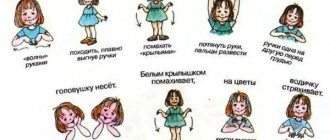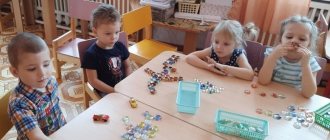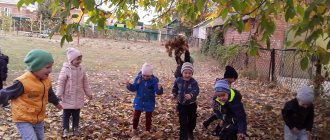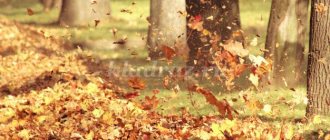Card index of walks. First junior group. Autumn card file (junior group) on the topic
- Card index of walks. First junior group. Autumn.
September
Walk 1
Watching a butterfly helps children develop a caring attitude towards insects and develop the ability to see the beauty of the world around them.
Game exercise “Come to me” - train children to run in a straight direction without stopping.
Didactic task “Big and small pebbles” - teach children to distinguish objects by size.
Work assignment “Let’s collect the toys at the end of the walk” - teach how to carry out simple tasks.
Individual work. Jumping forward.
Walk 2
Bird watching enriches children's understanding of the world around them.
The outdoor game “Bubble” is to strengthen children’s ability to stand in a circle, gradually expand and narrow it.
Didactic game “Recognize by sound” - develop auditory attention.
Labor assignment “Let’s collect sand in the sandbox” - teach how to carry out simple tasks.
Individual work. Game exercise “Walk along the path” - exercise children in walking in a limited area.
Walk 3
Watching a dog - involve children in observing pets, forming ideas about pets.
The outdoor game “Sunshine and Rain” - teach how to act on a signal.
Didactic game “Arrange by color” - teach to distinguish primary colors, group objects (sandbox molds) by color.
Work. Let's collect twigs on the site - involve them in carrying out simple tasks.
Individual work. Jumping on two legs.
Walk 4
Observing flowers in a flowerbed - to develop the ability to see the beautiful things around, to admire the beauty of flowers, to teach how to treat plants with care.
The outdoor game “Cat and Mice” is to teach how to walk in a circle, holding hands, and run in different directions with the end of the poetic text.
Didactic game “Choose a ribbon for the dolls” - teach to distinguish ribbons by length: long and short.
Work. We are building a road of sand - teaching us to work side by side with each other.
Individual work. Throwing at a target.
Walk 5
Observing a car that brings food to a kindergarten - involve in observing transport, learning to name the parts of the car: cabin, wheels, steering wheel, etc.
The outdoor game “Train” is to practice walking one after another, learning to start and end the movement at the teacher’s signal.
Didactic game “Big - small” - teach how to choose a home for a bear and a mouse. (Draw houses in advance with a stick on the ground or with crayons on the asphalt.)
Work. “Let’s sweep away the sand from the sides of the sandbox” - cultivate a desire to work together with the teacher.
Individual work. Practice walking in a straight line.
Walk 6
Observing the work of a janitor is to introduce adults to the work and support the desire to help.
The outdoor game “Catch up with me” is to teach you to run in a certain direction.
Didactic game “Recognize a friend by description” - learn to recognize your friends by the teacher’s description.
Work. We collect leaves - help the janitor.
Individual work. Jumping forward.
Walk 7
Observing the wind - introduce children to accessible natural phenomena, diversify play activities with the help of actions with pinwheels.
The outdoor game “Hit the Target” is to develop the eye and coordination of movements.
Didactic game “Bring the same object” - teach how to find a similar one among toys.
Work. Let's collect sand in the sandbox - involve them in carrying out work assignments.
Individual work. Repeat the Russian folk nursery rhyme “A fox with a little box ran through the forest.”
Walk 8
Bird watching - to cultivate an interest in the world around us, to maintain an interest in observing objects of wildlife, to cultivate a desire to take care of birds.
Outdoor game “Catch-up” - practice running.
Didactic game “Recognize by sound” - development of auditory attention.
Work. Collecting toys after a walk - cultivate a desire to put toys away after playing.
Individual work. Repeat the nursery rhyme “Big feet walked along the road...”
Walk 9
Observing the clothes of your own and those of passersby - to activate your vocabulary on the topic “Clothing”, to form knowledge about how to dress in the fall.
The outdoor game “Run to me” is to practice running in one direction without bumping into each other.
Didactic game “Find the Cub” - learn to find baby pets in pictures.
Work. Let's collect the leaves - cultivate the desire to carry out assignments.
Individual work. Draw with a stick in the sand - develop interest in drawing.
Walk 10
Excursion to the kindergarten garden - to develop knowledge about vegetables, learn to name them.
The outdoor game “Catch the Ball” is to teach how to run in a certain direction.
Didactic game “Orders” - teach to understand verbal instructions.
Work. Help in harvesting potatoes - cultivate a desire to help.
Individual work. Finger gymnastics “We chop and chop cabbage.”
Walk 11
Observation of clouds: white, the wind drives the clouds, they change shape - attract to observations of natural phenomena.
The outdoor game “Shaggy Dog” is to teach how to act on a signal, to run in different directions without bumping into each other.
Didactic game “Wonderful Bag” - learn to identify objects by touch.
Work. Collect sticks on the site - involve children in completing assignments.
Individual work. Climbing on a gymnastic wall.
Walk 12
Observing seasonal and weather changes in nature - to form elementary ideas about autumn changes in nature.
The outdoor game “Cars” is to train children in running in different directions, in the ability to start moving and stop at a signal.
Didactic game “What color?” - learn to distinguish passing cars by color.
Work. “Collecting twigs” - accustom to work.
Individual work. Game exercise “Raise your legs higher” - learn to step over objects 5-10 cm high.
Walk 13
Observation of transport - to form ideas about transport, about basic traffic rules.
The outdoor game “Cars” is to teach how to move around the area without bumping into each other.
Didactic game “On our site” - teach how to navigate in space, name familiar objects.
Work. “Take the toys to the group” - teach them to put away their toys themselves after a walk.
Individual work. “Catch and throw” - practice catching and throwing a ball.
Walk 14
Tree observation: what kind of trees? what kind of leaves do they have? how do trees shake their branches? – involve in observing the trees on the site, develop speech.
The outdoor game “Sparrows and the Car” is to teach how to act on a signal.
Didactic game “Who and where?” — learn to navigate in space, improve understanding of adult speech.
Work. Pour sand into the sandbox - teach how to carry out assignments.
Individual work. Speech game “Loud - Quiet”.
Walk 15
Observing the grass: note what color the grass is, how it feels, etc. – involve in observations of living nature objects.
The outdoor game “On a narrow path” is to develop a sense of balance.
Didactic game “Fox, dance!” - learn to distinguish the sound of instruments by ear.
Work. We sweep the sides of the sandbox - to cultivate the desire to work together with adults.
Individual work. Running on a straight path.
October
Walk 1
Monitoring the grass on the site. Conversation on the questions: “What color is the grass? What does it feel like? Who eats weed? Can kids eat weed? - develop thinking, speech, teach to distinguish colors, explain that you can’t put inedible objects in your mouth.
The outdoor game “Bear the Bear in the Forest” is to teach children to run in all directions.
The didactic game “Guess what to do” is to teach children to correlate the nature of their actions with the sound of the tambourine. Developing children's ability to switch auditory attention.
Work. “Let’s help the janitor clean the area” - to instill in children a desire to help adults.
Individual work. Throwing a ball at a distance.
Walk 2
Watching a cat is to expand your understanding of a pet – a cat. Cultivate a desire to care for animals.
Conversation on the topic: “Which animal lives at home with a person?” - develop speech, consolidate knowledge about domestic animals.
The outdoor game "Dashing - catching up" - learn to coordinate your actions with the actions of your comrades.
Didactic game “Sun or Rain?” — teach children to perform actions according to the different sounds of the tambourine, develop in children the ability to switch auditory attention.
Work. Game exercise “Collect leaves” - teach how to carry out work assignments.
Individual work. Exercise children in distinguishing between objects of contrasting sizes (a big house and a small house, a big ball and a small ball, etc.)
Walk 3
Observing transport - explain to children that cars drive on the roadway, the driver drives the car, and while driving in the car there is no need to distract the driver with conversations.
The outdoor game “Cars” is to teach children to run in different directions without bumping into each other.
Didactic game “Guess by Sound” - continue to isolate and recognize the sounds of individual musical instruments.
Work. Cleaning the kindergarten area - instilling a desire to help adults.
Individual work. Game exercise “Step over the stick” - develop the ability to step over objects and not lose balance.
Walk 4
Watching the leaves fall - show children the variety of colors of golden autumn; reveal a new concept of “leaf fall”.
Outdoor game “Who is quieter?” — train children to walk on their toes in the indicated direction.
Didactic game “Collect red and yellow leaves” - teach to distinguish between yellow and red colors.
Work. Collecting toys at the end of a walk is an accustom to work.
Individual work. Game exercise “Fetch the ball” - develop the ability to maintain a certain direction while walking.
Walk 5
Bird watching. Cultivate a kind attitude towards birds.
The outdoor game “Shaggy Dog” is to teach children to listen to the text and quickly respond to the signal.
Didactic game “Where did they call?” — teach children to determine the direction of sound.
Work. Collecting leaves in a pile - to cultivate a desire to help adults.
Individual work. Game exercise “Catch the ball”.
Walk 6
Observation of a birch tree. Examine the birch tree: the leaves have turned yellow, the breeze is blowing, the birch tree is swaying, dropping leaves.
Breathing exercise “Breeze”.
The outdoor game “Catch the Ball” is to develop the ability to maintain the required direction while walking and running.
The didactic game “Loud and Quiet” is to teach children to change the strength of their voice: speak either quietly or loudly.
Work. “Let's collect sand in the sandbox” - involve children in completing assignments.
Individual work. Running between two lines - develop coordination of movements.
Walk 7
Observation of the sky, conversation on the questions: “Show me where the sky is? What's in the sky? Who's flying in the sky? - develop speech, cultivate interest in the environment.
The outdoor game “Sunshine and Rain” - teaches how to navigate in space and act on a signal.
Didactic game “Guess by Voice” - teach children to distinguish between animals and birds by voice, to form verbs from onomatopoeic words (crows, meows, chirps, etc.)
Work. Collect branches on the site - involve in carrying out work assignments together with children of the older group.
Individual work. Game exercise “Step over a stick” - develop the ability to step over a stick without losing balance.
Walk 8
Observing flowers in a flower bed. Draw children's attention to the wilting of flowers. Form ideas about autumn changes in nature.
The outdoor game “Shaggy Dog” is to teach children to listen to the text and quickly respond to the signal.
Didactic game “One - Many” - teach to distinguish the number of objects.
Work. Offer to help the janitor collect leaves from the area. Cultivate a desire to help adults.
Individual work. Practice climbing a gymnastic ladder.
Walk 9
Observation of the wind - the wind blows, tears leaves from the trees. Introduces children to accessible natural phenomena and fosters interest in the world around them.
Breathing exercise “Breeze”.
The outdoor game “Cat and Birds” is to develop speed and agility.
Didactic game “Name the baby pet” - develop speech, consolidate knowledge about pets.
Work. Collect leaves in a certain place - involve in carrying out simple tasks.
Individual work. Game exercise “Catch the ball” - teach how to run in a certain direction. To train children in onomatopoeia - the “Who Says What” exercise.
Walk 10
Observing the sky (gray, drizzling, no sun, birds hidden) - to cultivate interest in the world around us.
The outdoor game “Across the Stream” is to teach how to step over obstacles.
Didactic game “Guess by Voice” - teach children to distinguish between animals and birds by voice, to form verbs from onomatopoeic words (crows, meows, chirps, cuckoos, etc.)
Work. “Collect pebbles on the site” - involve children in completing simple tasks.
Individual work. Repeat A. Barto’s poem “The Horse”.
Walk 11
Observing an earthworm, considering how it moves, telling where it lives - to cultivate interest in the environment.
The outdoor game “Giant Dwarfs” is to teach how to act on a signal, to walk without bumping into each other.
Didactic game “Big and Small Leaves” - teach children to distinguish objects by size.
Work. Helping the janitor clean the area encourages the desire to help adults.
Individual work. Remember the poem “Ball” by A. Barto.
Walk 12
Observation of trees: examine the trees, its main parts, offer to stroke the trunk - introduce objects of living nature.
The outdoor game “Birds in the Nest” is to teach walking and running in all directions.
Didactic game “Recognize by sound” - develop auditory attention.
Work “Collecting leaves in a bucket” - teach how to carry out simple tasks.
Individual work. Practice climbing a gymnastic wall.
Walk 13
Observing the work of a janitor, providing all possible assistance - to cultivate an interest in the work of adults and a desire to help.
The outdoor game “Shaggy Dog” is to develop the ability to run in different directions without bumping into each other.
Didactic game “Find a place for the dog” - teach how to navigate in space.
Work. Helping the janitor clean the area – maintaining the desire to help.
Individual work. Finger game “Magpie-magpie”, game exercise “Catch the ball”.
Walk 14
Observing street life: observing moving vehicles - learning to distinguish between vehicles: car, bus, tractor, truck, etc.
The outdoor game “Sparrows and a Car” is to introduce children to the basic rules of the road, practice running in different directions, teach them to run without bumping into each other.
Didactic game “Big - Small” - develop attention, thinking, learn to classify objects by size.
Work. Sweep in the gazebo - get used to work.
Individual work. Repeat the nursery rhyme “Bai-bai - you, little dog, don’t bark.” Train children in jumping while moving forward from a standing position.
Walk 15
Observing children's clothes and shoes - enriching the vocabulary (overalls, jacket, boots, boots, etc.).
The outdoor game “Legs” is to create a good mood, continue to teach you to listen to adults.
Didactic game “Wonderful Bag” - to help develop the ability to examine objects.
Work. “Let’s gather the twigs in a heap” - to cultivate the desire to work.
Individual work. Game exercise “Step over the stick” - practice stepping over obstacles.
November
Walk 1
Observation of a tree. Introduce children to the signs of autumn (trees shed their leaves), develop a caring attitude towards nature (tree branches should not be broken).
The outdoor game “Catch Me” is to teach students to run in a certain direction without bumping into each other.
Didactic game “Tall and Low Trees” - teach to distinguish trees by height.
Work. Let's collect pebbles on the site - teach them to carry out the simplest instructions.
Individual work. Remember the nursery rhyme “Our ducks in the morning.” Practice climbing a gymnastic wall.
Walk 2
Observing the weather of the day - forming ideas about autumn changes in nature.
Outdoor game “Bubble” - develop the desire to play outdoor games with the teacher.
Didactic game “One - Many” - teach to distinguish the number of objects.
Work. We collect leaves in a bucket - to cultivate the desire to work together with adults.
Individual work. Finger gymnastics “Finger-boy, where have you been?”
Walk 3
Observing the wind - pay attention to the branches of the trees, to the leaves, how they are quietly swayed by the wind. Invite the children to pretend to be a breeze - the “Breeze” breathing exercise.
The outdoor game “Cat and Mice” is to develop motor activity, teach to act on a signal, to run without bumping into each other.
Didactic game “Guess by Description” - learn to guess from the description which of the children the teacher guessed.
Work. Sweep in the gazebo - teach how to carry out simple tasks.
Individual work. Exercise children in catching a ball.
Walk 4
Observing the work of adults - to cultivate interest in the work of adults.
The outdoor game “Who is Quieter” is to train children in walking on their toes.
Didactic game “One-Many” - teach to distinguish the number of objects.
Work. Providing all possible assistance in clearing the area of leaves - fostering a desire to help.
Individual work. Throwing a ball long distance with the right and left hand.
Walk 5
Observation of the roadway - to give an idea of the rules of the road.
Outdoor game “Where is it ringing?” - learn to navigate in space.
Didactic game “Curious Doll” - teach children to answer the questions “who?”, “what?”, “what does it do?”
Work. We collect the twigs in one place - teach them to carry out simple tasks.
Individual work. Train children to jump in place.
Walk 6
Bird watching - talk about the fact that as cold weather approaches, birds have less food, and people should take care of them. Cultivate a caring attitude towards birds.
Outdoor game “Legs” - practice alternating movements (running, walking, jumping, squats).
Didactic game “Guess by Sound” - continue to isolate and recognize the sounds of individual musical instruments.
Work. Sweep in the gazebo - involve in carrying out work assignments.
Individual work. Jumping on two legs while moving forward.
Walk 7
Observing the rain is to reinforce ideas about autumn changes in nature: it rains often, it’s damp and cloudy outside.
Outdoor game “Cat and Mouse” - practice running on a signal.
Didactic game “Name the color” - teach to distinguish primary colors.
Work. Collecting toys at the end of a walk - fostering a desire to carry out work assignments.
Individual work. Climbing a gymnastic wall.
Walk 8
Observation of trees - draw children's attention to branches without leaves, tell them that trees shed their leaves in the winter - introduce them to objects of wildlife, cultivate a caring attitude towards trees.
The outdoor game “Catch Me” is to train children in running and walking in a certain direction.
Didactic game “What is this?” — enrich children’s vocabulary with nouns that denote the names of the objects around us.
Work. Helping the janitor clean the area - instilling a desire to help adults.
Individual work. Conversation “What are the names of your relatives?”
Walk 8
Observing the weather of the day - to form elementary ideas about autumn changes in nature.
The outdoor game “Aim More Accurately” is to develop the ability to hit the target.
Didactic game “Who is dressed in red?” - learn to distinguish the color red in the clothes of your comrades.
Work. Collecting twigs, game “How many twigs did you bring?” - cultivate interest in work, teach to distinguish between the number of objects.
Individual work. Repetition of the nursery rhyme “Our Masha is little...”
Walk 9
Observing ice on puddles. Draw children's attention to the changes that have occurred in nature.
The outdoor game “Across the Stream” is to develop the ability to move in a certain direction, jump on two legs and move forward.
Didactic game “One-Many” - teach to distinguish the number of objects.
Work. We collect pebbles in a bucket - teach how to carry out simple tasks.
Individual work. Game exercise “Find a toy” - teach how to navigate independently in space.
Walk 10
Observation of trees - to form ideas about the living nature around us.
The outdoor game “The little gray bunny is sitting” is to teach you to listen to the text and perform movements in accordance with the content: clap your hands, jump on the spot.
Didactic game “Sun or Rain?” — teach children to perform actions according to the different sounds of the tambourine, develop in children the ability to switch auditory attention.
Work. “Let’s sweep in the gazebo” - involve in carrying out simple tasks.
Individual work. Learn to walk in pairs.
Walk 11
Observing snow - forming basic ideas about changes in nature.
The outdoor game “Find a toy” is to teach how to find a certain object and walk in the indicated direction.
Didactic exercise “Tell Mishka how to behave during a walk” - to reinforce the rules of behavior during a walk.
Work. Let's sweep around the gazebo - involve them in carrying out assignments.
Individual work. Remember A. Barto’s poem “Bull.”
Walk 12
Observing the weather of the day - draw the children’s attention to the fact that it is snowing, it covered the ground and grass. What colour is he? What does it feel like? – develop speech, thinking, broaden children’s horizons.
The outdoor game “Aim More Accurately” is to develop your eye and accuracy.
Didactic game “What’s rolling?” - introduce children to the properties of objects.
Work. Let's sweep the path from the snow - cultivate the desire to work together.
Individual work. Running between two lines - learn to run in a straight line.
Walk 13
Observing the weather - forming basic ideas about changes in nature.
The outdoor game “The little white bunny is sitting” is to teach you to listen to the text and perform movements in accordance with the content.
Didactic game “What is missing” - to develop attention and memory.
Labor assignment “Sweep the sides of the sandbox” - teach how to carry out simple tasks.
Individual work. Practice climbing a gymnastic wall.
Walk 14
Bird watching – cultivating a caring attitude towards birds.
The outdoor game “Sparrows and a Car” is to train children in running in different directions without bumping into each other, in the ability to start a movement and change it at the teacher’s signal.
Didactic game “Who is this? What is this?" — teach children to answer simple questions.
Work. We collect branches in a pile - to cultivate the desire to carry out the simplest tasks.
Individual work. Game exercise “On a narrow path” - practice walking in a straight line.
Walk 15
Observing children's clothes - to form an idea about clothing and its purpose.
Didactic game “Who is wearing what?” — enrich children’s vocabulary, teach them to answer questions.
The outdoor game “Catch the Bear” is to teach you to run when given a signal.
Work. Invite children to sweep the path - cultivate a desire to carry out assignments.
Individual work. Finger gymnastics “Three bears sat.”
Summary of an autumn walk in the junior group of kindergarten
A walk in the younger group of a preschool educational institution on the topic: “Leaf fall, leaf fall - the leaves are spinning, flying”
Author: Chelpanovskaya Olesya Anatolyevna teacher of the secondary educational institution No. 9 “Snow White” of a general developmental type in the city of Ishimbay. Description of the material: I offer you a summary of an autumn walk for children of the second junior group. This material will be useful for educators and parents. A walk helps develop children's curiosity and physical activity.
Integration of educational areas: “Cognition”, “Speech development”, “Social and communicative”, “Physical development”. Purpose: To introduce children to the autumn natural phenomenon - leaf fall. Objectives: Educational:
To attract children's attention to the phenomenon of the surrounding reality (leaf fall).
Continue to teach children to run in circles, scattered, without bumping into each other. Developmental:
develop cognitive interest, attention.
Educational:
To develop the ability to see and notice the beauty of our native nature.
Continue to instill in children a desire to participate in work. Methodological techniques: Game situation, conversation - dialogue, outdoor games, outcome. Preliminary work: Examining a birch tree, observing the wind. Reading fiction: E. Blaginina “Autumn”, E. Trutneva “Autumn”. Learning the game “leaves, leaves.” Listening to the song “Falling Leaves”, music by T. Potapenko. Progress of the walk: I. Exit to the kindergarten site. The teacher is a storyteller, wears a beautiful scarf, and holds a basket. The children stop at the birch tree. Educator: Today, I will tell you a fairy tale about the wind. “Once upon a time there lived a little Veterok who loved to fly everywhere. One day Veterok flew past our kindergarten and saw beautiful trees with yellow leaves (point to the tree). The breeze liked them very much. He sat down on a branch and asked: “Who are you?” “We are leaves, mothers are sons of trees,” he heard in response. “Would you like to fly with me, little leaves? It's so fun and interesting!” - Veterok suggested. And the leaves answer: “We want to fly, but we don’t know how.” “And I’ll help you,” exclaimed Veterok and ran along the branches of the trees - wow!” The leaves grabbed the Breeze and spun with it in the air. How much fun they all had!” Children 2-3 min.
Observe leaf fall. The teacher pronounces the words together with the children: The green garden has turned yellow, the leaves are spinning and flying.
Leaf fall has arrived. Educator: It gets colder in the fall, the leaves on the trees change color. Leaves fall. Dry leaves rustle underfoot. II. Looking at a birch tree and its leaves. Questions for children. —Where did the leaves fall from? - What is the name of the tree? — Why did the leaves fall? Where do they fall? — What color are the leaves? Draw the children's attention to how many leaves there are on the ground. Educator: Now we will play with leaves. Collect leaves. Examination of birch leaves (color, size). D/game “Find a large birch leaf”, “show a small leaf”. Children pronounce the words: big, small, yellow. III. Outdoor game “We are leaves.” We are leaves, we are leaves. We are autumn leaves We sat on the branches, The wind blew and we flew, We flew, we flew - All the leaves were so tired! The breeze stopped blowing. Everyone sat down in a circle. The wind suddenly blew again and blew the leaves off the branches. All the leaves flew and sat quietly on the ground. Children stand in a circle. Raise the leaves up and lower them. They run in a circle, waving leaves. They squat in a circle. They scatter in different directions, run and sit down. IV. Labor in nature. Game situation. The teacher brings out a toy hedgehog. He needs leaves for his bed. Invite the children to help the hedgehog collect leaves. Children collect leaves. Praise the children. V. Independent activity of children. Individual work with children on the development of basic movements. VI. Invite the children to travel in a group on the train. Children stand one after another. The teacher asks “What interesting things did we see on our walk today?” Children “How the leaves flew” “Leaf fall”, “We played a game - leaves.”
Invite parents to learn a poem with their children.
Falling leaves Everywhere - everywhere - Falling leaves, Falling leaves.
Leaves on the ground fly and fly. Mischievous - Here and there, There and here! The leaves are swept and swept by the wipers... And they again fly and fly... Oh, this Fall of Leaves, Fall of Leaves! Alexander Shibaev
We recommend watching:
Summary of an autumn walk in the 2nd junior group Fairy tale for children 3-4 years old. Autumn in the forest Abstract of GCD in the second junior group on the topic: Autumn Application for children of the junior group in kindergarten. Hedgehog with mushrooms
Similar articles:
Indoor games in kindergarten in the fall. Junior group





